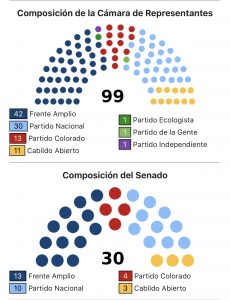Uruguay recently concluded its electoral process, once again consolidating its civility and democratic vocation after a very close electoral result. Luis Lacalle Pou, representing the right and from the National Party, won the second round election by the narrow 1.5% margin (less than 38 thousand votes, with 38,024 blank votes, 53,193 voided and 395 observed rejected). A few hours after the Supreme Court confirmed these results, the new president and his contender from Frente Amplio, Daniel Martínez, had a frugal, cordial, personal and respectful meeting.

After the dictatorship that governed Uruguay between 1973 and 1985—when 100 people died and about 170 disappeared—, eight presidents have been elected democratically, without interruption. The last three, before the election of Lacalle Pou, have been members of Frente Amplio, a coalition that oscillates between the left and the center-left: Tabaré Vázquez (March 2005 – March 2010); José Mujica (March 2010 – March 2015); and Tabaré Vásquez’s second term, from March 2015 to March 1, 2020, when he will pass the command on to the newly elected president.

However, Frente Amplio will have to assume the enormous responsibility of maintaining a majority in the parliament, after 15 years of consecutive ruling. The Party has 42 representatives (7 from being a majority) and 13 senators (two seats from controlling the upper chamber). It should be noted that the Colorado Party (a social-democratic formation) achieved 13 representatives and four senators; the Cabildo Open party (conservative nationalist group) has 11 representatives and three senators.

Therefore, both the Lacalle’s administration and the legislative body will have to find moderation and understandings, acknowledging that the conditions of the world economy are not those from previous years, that the global scenario is increasingly complex, and that Uruguayan society, fortunately, has increasing expectations about its rights and its future. Let’s look at some of the challenges the new Uruguayan leadership will face.
Against the tides of what’s happening in Latin America, the Oriental Republic of Uruguay has a low population growth rate. In 2010, the then-president José Mujica summed it up in a bleak phrase. He said Uruguay was a country “in danger of extinction.” That same year’s census estimated the country had a population of approximately 3,286,000 inhabitants, which represented a small growth compared to 2004. According to World Bank projections, in 2017, it had already crossed the line of 3,457,000 inhabitants.
With a population that still does not reach 3.5 million inhabitants, Uruguay is the second smallest country in the continent, after Suriname: 176,215 square kilometers. When you look at its location on the map, the disproportion is evident. It is a country that has borders with three immensities: Brazil, Argentina and the vastness of the Atlantic Ocean.
Since the end of the 19th century, Uruguay enjoys a peculiar privilege: that of being a country with an excellent reputation. At that time, it was nicknamed “the Switzerland of America.” Some of its merits have a historical character. One of the most prominent, without a doubt, was the establishment of an educational system in 1877, founded on the principles of free, compulsory and secular. This step has probably had an enormous impact on social and cultural developments. Not to mention, the nation has gifted the world with writers such as José Enrique Rodó, Horacio Quiroga and Juan Carlos Onetti.
But there is more: in 1917, Uruguay established the right to divorce, an example that did not go unnoticed for legislators from other countries around the continent. Another significant fact: it was the sixth country in the world and the first in Latin America to recognize women’s right to vote, in 1938, a decade ahead of the UN, which included it in the Universal Declaration of Human Rights, in 1948.
The fact that it is a small nation—territorially and demographically—has some advantages that must be emphasized. In 2018, for example, UNESCO reported that more than 98.5% of Uruguayans were literate, with a slightly higher percentage in women (98.87%) than in men (98.15%). The World Bank, for its part, highlights Uruguay’s trend towards an egalitarian society, whose high per capita income exceeds $16,000 a year, with low inequality rates and strikingly low poverty rates.
In January 2019, ECLAC indicated that 10.2% of Latin America’s population lived in conditions of extreme poverty, at the end of 2017. This means that 62 million people survive on incomes below their basic needs. The same report showed an alarming general poverty rate of 30.2% or 184 million people. With these data as background, Uruguay stands out, according to ECLAC methodology, for its very low level of poverty: 2.7%. This figure disagrees with the formula of the Uruguayan government, which speaks of poverty levels of almost 8%—still a magnificent performance, when compared to the rest of the region and the fact that, in 2006, poverty reached a third of the population.
A concrete expression of these data, visible to any visitor, is the almost total absence of destitution in the streets of Montevideo and the most populated cities. In the World Bank’s so-called Human Opportunity Index, which measures the presence of elements that can affect the development of children and young people, “high levels of equal opportunities in terms of access to services such as education, drinking water, electricity and sanitation” is emphasized. More than 60% of Uruguay’s population belongs to the middle class.
A CCN en Español report in February of this year stated that, according to International Transparency indicators, Uruguay tops the ranking of lowest perception of corruption in Latin America. There are many analysts who agree that, in general terms, Uruguayan society maintains acceptable levels of trust towards its political leaders: they may or may not agree with their opinions and proposals, but, unlike what happens elsewhere, the population does not suspect that the politicians have joined political activity with the sole purpose of stealing public coffers. Ricardo Gil Iribarne, president of the Board of Transparency and Public Ethics (JUTEP, founded in August 2015) has cited some factors that have kept corruption under control, including institutions’ efforts to protect their solidity, the clear distinction between divisions of power and the government’s developed capacity to react to cases that have arisen.
The same cannot be said about crime. Between 2010 and 2017, the total homicide figures varied between 104 and 163 homicides per year. In the year 2018, unexpectedly, there was a jump in the number: 218 murders occurred, which substantially impacted the public’s opinion: violence has become the primary concern of Uruguayans. For the first time in its history, the average homicide rate entered in the two-digit category: 11.8 homicides per 100 inhabitants, surpassing Peru (7.7), Bolivia (6.3), Argentina (5.2) and Chile (2.5). Thefts and robberies have also increased. Violent robberies went from 9,282 in 2017, to 14,459 in 2018—an increase of more than 64%, from one year to the next.
When these data are contrasted with the performance of the economy, there is a distinct scenario of non-correspondence. Between 2003 and 2010, there was a significant annual growth of 5.4%, on average. Between 2011 and 2018, it fell to 2.8%. This yields an average of 4.1% in that decade and a half. They are, in the words of experts, good results if they are confronted with the difficulties faced by the economies of the two neighboring giants, Brazil and Argentina. Uruguay seems to have left behind the times when its development depended, to a large extent, on the pace of the other two countries. It has an unemployment rate that ranges between 8 and 9%, according to data from the official National Statistics Institute. The estimate is below that of Brazil (approximately 13%) and Argentina (approximately 11%).
One of the Uruguayan secrets is the prudent management of macroeconomic guidelines. The supply of export products has been diversified. In addition to their traditional exports of bovine meats of different types—refrigerated or frozen—, there are the chemical wood pulp, soy and derivatives, rice, dairy products, cereals, barley malt, wool and other products, some of marine origin. The expansion has also occurred in terms of destinations, which has allowed mitigating the impact of the crisis in Brazil and Argentina. Uruguay has managed to diversify its clientele and today has China, the United States, the Netherlands, Mexico, Germany, Turkey, Italy and other countries as the destinations of its exports.
This opening to international markets has not only had the fortune of reducing poverty and accelerating the growth of the middle class but also allowed the necessary funds to extend the coverage of social programs. I read that almost 87% of the population over 65 is covered by the pension system.
This is an especially strategic year for Uruguay. The International Monetary Fund has ratified its estimate of a 1.9% growth for 2019, and a projection of 3% growth in 2020. With these perspectives, the country will have to continue facing some structural problems that hinder a faster course towards more sustainable progress: failures in road networks and, in general, in transport infrastructure, the high cost of energy, and water and sanitation systems failures.
Education is one of the fundamental obstacles that will have to get resolved by thinking about the opportunities that come from the planet’s commercial exchanges and the demands of the digital revolution. Experts and institutions are alarmed by the issues with the quality of education, school dropout and repetition rates, the gaps between primary and secondary school, labor conflicts, among others. They are questioning which capabilities the small nation will need to face the challenges of the next two decades.
Finally, Lacalle must maintain a climate of social peace in a convulsed region. Its Mercosur neighbors oscillate between an extreme right-wing populist government in Brazil and an Argentina that has returned to Peronism. It is still too early to know if that country will return to the Kirchner vision of left-wing populism—given that Cristina Fernández de Kirchner will be the vice president—, or if Alberto Fernández will govern with criteria closer to a social-democratic moderation. Meanwhile, Bolivia’s future is yet to be defined, without Evo Morales and a pending electoral process full of uncertain elements. Paraguay’s hegemony of the right still governs. Lastly, in Chile, though not part of Mercosur, with an impact on the subregion’s economic performance, is traversed by an unexpected uncertainty.
But beyond the uncertain and varied political map, the economic projections of the entire subregion (as in the rest of Latin America) are not the best. Argentina, whose economy is vital for Uruguay, will close this year with a fall of 3.9% of GDP, and the average of estimates projects a decline of another two percentage points next year. Brazil will continue to experience meager growth, just like Chile. And in Venezuela, given the political closeness that was built between Frente Amplio and Hugo Chávez, the economic outlook is frankly bleak.
By the way, the Venezuelan crisis represents another challenge for the new government. Already Frente Amplio had moved from supporting the Maduro regime to a shy friendship or critical neutrality in an effort to position itself as a friendly and mediating country in the search for peaceful and consensual exits. We will see where Lacalle takes things, precisely at a time when the “interim presidency” of Juan Guaidó is prolonged and seems to weaken against the de facto regime still in control of the country, headed by the military coalition that supports Nicolás Maduro, despite to his spurious reelection in 2018. In that sense, it is worth noting that the internal situation in Venezuela, the change of power in Argentina and the regional context of crisis, predict a relative hardening against Maduro, but always in a practical exercise and prudent results of the circumstances.
That is the situation and context in which President Luis Lacalle Pou will take office next March. A country in a different position, but with parallel and similar political, social and economic challenges, his father, Luis Alberto Lacalle, faced when he was president of Uruguay between 1990-1995.
